Komtar
The Tun Abdul Razak Complex (Malay: Kompleks Tun Abdul Razak), colloquially known by its Malay acronym KOMTAR, formerly known as the Penang New Urban Center and the Central Area Redevelopment Plan for Penang, is a complex located in the city of George Town, Penang, Malaysia. The complex comprises retail outlets, a transportation hub, and a skyscraper, containing the administrative offices of the Penang state government. It was named after Abdul Razak Hussein, the second Prime Minister of Malaysia, who officiated the construction of the complex. The tower is the nineteenth-tallest building in Malaysia, behind the MAS Annex in Kuala Lumpur. Upon completion, it was the tallest building in and Malaysia, a position it retained until 1988 when it was surpassed by the completion of the Maybank Tower.
| Tun Abdul Razak Complex | |
|---|---|
Malay: Kompleks Tun Abdul Razak (KOMTAR) | |
 KOMTAR in 2023 | |
| General information | |
| Type | Government offices, commercial offices, retail |
| Location | Penang Road, George Town, Penang, Malaysia |
| Construction started | 1974 |
| Completed | 1988 |
| Renovated | 2016 |
| Cost | RM880 million |
| Height | |
| Roof | 248.7 m (816 ft)[1] |
| Observatory | 247.9 m (813 ft) |
| Technical details | |
| Floor count | 68 |
| Floor area | 71,080 m2 (765,100 sq ft) |
| Lifts/elevators | 30 Mitsubishi/Hitachi/Toshiba/Fujitec Elevators |
| Design and construction | |
| Architect(s) | Architects Team 3 Jurubena Bertiga International Sdn Bhd |
| Structural engineer | Ove Arup & Partners |
| Renovating team | |
| Renovating firm | Only World Group |
| References | |
| [2][3][4][5][6] | |
The first phase of the construction of the complex started in 1974, and was completed in 1988. When the skyscraper topped out in 1985, it was completed with 65 floors and a height of 231.7 metres (760 ft). At the time of its completion, the skyscraper was the third-tallest building outside the Western Hemisphere (after Sunshine 60 in Tokyo and One Raffles Place in Singapore). The building maintained its status as the country's tallest skyscraper for another two years before being surpassed by the 243.5 m (799 ft) Menara Maybank in Kuala Lumpur in 1988. As of 25 October 2023, Komtar Tower's status as Penang's tallest skyscraper remains unchallenged.
During refurbishments in 2015, 3 more floors were added on the skyscraper, raising the height to 248.7 m (816 ft). In addition, Komtar Tower is home to the Rainbow Skywalk, the highest glass skywalk in Malaysia, which has been installed at the top of the skyscraper, the skywalk is at the height of 247.9 m (813 ft) and it was launched in 2016.[6][7] Further efforts to revitalise Komtar include the launch of The Gravityz, billed as the world's highest rope course, at the exterior of the skyscraper's 65th floor in 2018.[8][9][10]
Komtar is known for being one of the most notable uses of modernist and brutalist architecture in Asia. Komtar's legacy remains controversial: some noted it as an icon for Penang's post-industrialization prosperity after the 1970s; others equate the building with urban decay and the intentional destruction of local traditional heritage, looking out of place amidst the historic cityscape of central George Town.
History
Background
The 11 acres (4.5 ha) site from which Komtar now occupies was originally a stretch of the Prangin River, which ran through a swamp. Upon the outbreak of the Napoleonic Wars, the construction of a defensive stone canal began under probable directions from the British East India Company[11] in 1804. The canal was approximately 50 to 80 feet (15 to 24 metres) wide.[12] Its base was constructed with bakau pillars and shorewood, a common construction technique of the time in Penang, and was filled with granite blocks. The canal was meant for agricultural and commercial uses, and it marks the furthest boundaries of George Town. The location of the canal, being at the very end of the town, was first noted by the Malay population under the name Ujong Pasir, and was later remarked by the local Chinese population in Hokkien as Sia Boey, both coincidentally carrying the same meaning of the 'end of the village' (other historians suggested Sia Boey might also mean 'a place to sell scrap, or cheap sundry'[13]) The canal was narrowed during the 1890s to a width of 20 feet (6.1 metres) and a depth of 5 feet (1.5 metres).[14]
The region, populated since the mid-19th century, became a dense metropolitan area after the arrival of Chinese immigrants from the Hui'an region of Fujian, China.[13] There were five major roads that occupied the site: Magazine Road, which runs within the city centre until the Magazine Circus; Penang Road, which runs from Farquhar Street to Brick Kiln Road (now Gurdwara Road); Prangin Road (now Dr. Lim Chwee Leong Road), which ran along the Prangin Canal; Maxwell Road, the northernmost road of the Seven Sisters Precinct; and Gladstone Road, which ran from the Magazine Circus, to the junction between Penang Road, Mcnair Street, and Carnarvon Street. In the 1880s, the Sia Boey Market was constructed, made of cast iron. A drinking fountain was also set up at the place.
The region was also noted for the Magazine Circus (Magazine Junction), a roundabout converging on a junction of six roads, where the Gladstone Road, Macalister Road, Brick Kiln Road, Dato Keramat Road, Magazine Road and Penang Road coincide. The Malays called it Simpang Enam, carrying the literal meaning of 'the six-way junction'; the Chinese called it the Go Pha Teng, which means 'the five lamps', referring to the Municipal lamps set up at the middle of the junction. The junction was where the first traffic lights in Penang were set up in 1928.
The area suffered great destruction during the Second World War. Between 10 and 13 December 1941, the city was bombed by Japanese bombers. The regions around Penang Road, which were filled with upturned rickshaws, were mistaken by the bombers as anti-aircraft guns; and thus were bombed heavily with serious casualties. A bomb in particular, scored a direct hit on the Sia Boey Market, which was by then the most populated market in Penang.[15]
Planning
The decline of George Town as a major entrepot in the late 1950s, exacerbated in the following decade when Penang's free port status was revoked, created recessions. Proposals to rejuvenate the city-centre were first devised in 1962. In 1969, then newly appointed Chief Minister of Penang, Lim Chong Eu approved the formation of the Central Area Redevelopment Plan. The urban plan called for preservations of heritage and modern developments in the city. Design was carried out by Architects Team 3 (AT3), led by Lim Chong Keat, Lim Chong Eu's brother. The construction was to mark the arrival of a shift in Penang's stagnancy, the start of a period of industrialisation, embracing modern approaches to its architecture. It was meant to revitalise the city of George Town by creating a complex that would house administrative, commercial, retail and transportation functions under one roof, as well as projecting Penang's relative new modernist architectural scene in the post-independence era. The urban renewal effort was first proposed in 1962.[16] A report from Robert Nathan recognised that George Town was beginning to show signs of decline, with the majority of the city's residences consisting of 19th-century shophouses that were in derelict conditions and had turned into slums.[17]
By the time Lim Chong Eu took over as the Chief Minister of Penang in 1969, the state of decline in Penang had been exacerbated by the revocation of Penang's free entrepôt status. Thus, the Komtar project was seen as an attempt to reverse the declining fortunes of George Town and revitalise both the city and the state of Penang as a whole.
Design
.jpg.webp)
A masterplan for George Town drawn up in the 1960s called for the conservation of the historic city centre as a heritage site, whilst an 11-hectare area bounded by four roads—Prangin, Maxwell, Penang and Magazine Roads—was to be developed into the 'Penang New Urban Centre' consisting of a four-storey podium, three 17-storey residential blocks and a central 65-storey skyscraper.[16] The proposed complex also included a geodesic dome inspired by the designs of Buckminster Fuller, a colleague of Lim Chong Keat.
The central skyscraper was to house administrative offices of the Penang state government, while the geodesic dome would contain a multipurpose hall. As noted by Gwynn Jenkins in her book, Contested Space, the three residential blocks were to provide a 'socially-engineered residential community' in flats of mixed-income and ethnicity. In addition, the complex was also planned to serve as a commercial district and a public transportation hub, all of which were to be condensed under one roof.
The skyscraper shape is from a 12-sided cylindrical shape.
The complex was designed by Architects Team 3 (AT3) of Singapore, led by Lim Chong Keat.[18][19] Lim recounted that he was responsible in making sure that the appointed consultants were competent, and of sufficient national and worldwide standing required to accomplish the project.[17] Experts of other fields, including social researchers from Universiti Sains Malaysia (USM) and a traffic consultant were also included.
Construction
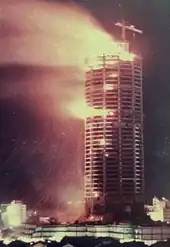
The Komtar project only got off the ground in 1970, during the tenure of Lim Chong Eu as the then Chief Minister of Penang.[16] It was the single most ambitious urban renewal project undertaken by Penang Development Corporation, the development arm of the Penang state government. The master plan was divided into five phases of implementation.
However, the Komtar project also entailed the destruction of hundreds of colonial-era shophouses, schools and temples around the 11-hectare site, displacing the more established neighborhoods in the process.[20] Notably, Gladstone Road, which once ran through the area, was wiped off the map when the construction of Komtar commenced.
The then-Prime Minister of Malaysia, Tun Abdul Razak Hussein, officiated the first piling ceremony on 1 January 1974, during which he clarified that the project would change the city's appearance and discard the colonial heritage image in favour of one which reflected the identity of Malaysia and its multi-ethnic culture.[16]
Komtar Tower was topped out in 1985, making it the tallest skyscraper in Malaysia at the time.[21] The 65-storey, 232-metre-tall skyscraper was also the second-tallest in Asia at that point, behind Sunshine 60 in Tokyo, Japan. Komtar Tower was officially completed the following year and remained as the tallest skyscraper in Malaysia until 1988.
| Date | Event |
|---|---|
| 1 January 1974 | The first piling of the Komtar Tower one was done by the late Tun Abdul Razak, the second PM of Malaysia. |
| 2 December 1976 | Part of the complex's first phase podium block was completed in 1976. |
| 23–24 January 1983 | A fire broke out at the 43rd floor of the Komtar Tower and destroyed the floors above it. Firemen were unable to put out the flames as it was too high up. The flames eventually burnt out after approximately eight hours. The skyscraper was still under construction at that time and it was one of the worst high-rise fires in the country.[22] |
| 1986 | Phase 1, Phase 2A and Shangri-La Hotel (now Jen Hotel) open. |
| 1988 | Construction of the 65-storey Komtar Tower is completed. |
| 1997 | Construction of Phase 3, Prangin Mall begins. |
| 2000 | Prangin Mall opens. |
| 2005 | The long-time anchor tenant at the mall, Super Komtar, a local department store chain folded in. Another department store, Aktif Lifestyle (formerly Yaohan) occupying the adjoining block, has also ceased operations. |
| 1 May 2008 | The new Penang state government, led by the Pakatan Rakyat opposition coalition, reaffirmed its commitment to revitalise Komtar by cancelling the relocation of its administrative offices to Bayan Mutiara. |
| 17 December 2008 | A new anchor tenant named Pacific took over Super Komtar Supermarket & Departmental Store as the main anchor tenant with a floor space of over 100,000 square feet (9,300 m2). Upgrading and renovating works on Phase 2A completes. |
| 19 August 2009 | Komtar Walk was opened outside Pacific's main entrance. It features 19 F&B outlets and open space. 1st Avenue, Phase 4 commenced construction. |
| 27 May 2010 | Popular Bookstore, which opened in Komtar at 1991 and was the first Popular outlet outside Kuala Lumpur, returned to its former location after moving to Prangin Mall in 2004. The store in Prangin Mall has since ceased operations. |
| 17 August 2010 | Requests for Proposal (RFP) were called by the state government to rejuvenate the open space of the level 5 podium and a geodesic dome, levels 59 and 60 of the tower, and the installation of an outdoor bubble lift linking level 5 and the level 65 rooftop.[23] |
| 17 November 2010 | ICT Mall @ Komtar opens. |
| 25 November 2010 | 1st Avenue Mall opens. |
| 31 July 2012 | Penang Heritage Square announced for Phase 5 development. |
| 29 October 2013 | RM50 million Komtar revitalisation and rejuvenation project covering levels 5, 59, 60, 64 and 65 kicks off by Only World Group Holdings Berhad (OWG).[24] |
| 1 June 2015 | 59 Sixty Restaurant on levels 59 and 60 of tower block opens for business. |
| 18 September 2015 | OWG takes over the management of Komtar multistorey car park and upgrading works have been carried out over six months. Level five of the nine-level car park will be dedicated to women drivers only for security reasons, where shoppers can access the upcoming shopping arcade directly as they exit the car park.[25] |
| 20 January 2016 | Revitalisation project expanded to include the construction of three additional levels (levels 66, 67 and 68) and new spaces (levels 3, 4, 5 and 6).[26] |
| 16 July 2016 | Official launch of Tech Dome Penang.[27][28] |
| 18 December 2016 | Official launch of The Top @ Komtar.[29] |
| February 2018 | The Gravityz, a rope course along the exterior of the 65th floor, was launched.[8][9][10] |
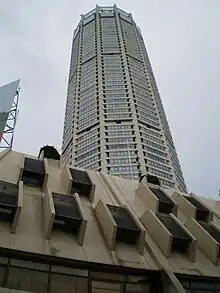
Decline
As part of Phase 1, Komtar Tower had been completed in 1986. However, out of the original five phases, only Phases 1 and 2A, the latter which involved the creation of Komtar Walk, a 155-metre-long walkway lined with food outlets, was never completed according to plan. Phases 3 and 4 were jointly developed with private firms into Prangin Mall and 1st Avenue Mall, respectively.
While Komtar was originally built to revitalise George Town, by the early 2000s, it became a white elephant itself.[20] The displacement of entire neighbourhoods and businesses during the construction of Komtar in the 1970s and 1980s caused the vicinity of Komtar to become depopulated, thus depriving the retailers within Komtar of a catchment area.[16] The 1997 Asian financial crisis exacerbated the decline of Komtar, while the completion of newer shopping malls throughout George Town led to retailers in Komtar shutting down in droves.[30] Potential tenants and the general public alike were also unimpressed by Komtar's poor maintenance, its confusing interior layout and dark, garbage-strewn corners.
It was estimated that, as of 2008, some 40% of the retailers in Komtar had left the skyscraper, while many others simply left their shop lots closed.[16][30]
Revitalisation
As part of the Penang state government's initiative to regain the glory days of Komtar, a revitalisation effort was launched in late 2012. Only World Group (OWG) was awarded the RM50 million renovation project, which included the construction of a banquet hall at level 5, a 30,000-square-foot boulevard to house food and beverage (F&B) outlets, an international-themed restaurant at levels 59 and 60, a sky restaurant at level 64 and a sky lounge at level 65.[30]
in 2015, three new floors were added onto the Komtar Tower, thus increasing its height to 249 metres.[26] The top floor (68th floor) was topped with a rooftop Sky Bar, as well as the highest glass skywalk in Malaysia.[31] Dubbed the Rainbow Skywalk, the 16-metre semi-circular glass skywalk is also the first of its kind in Southeast Asia. The U-shaped glass walkway is constructed from the same glass material as that of Grand Canyon Skywalk and is designed to withstand a total weight of 16 adults.[7][31]
Three high-speed bubble lifts were also installed, two of which connect a theme park at level 5 to levels 65, 66 and 67, while the other links level 59 with the level 68 summit.[32] While the bubble lifts were initially designed with a transparent glass wall to allow for a panoramic view of George Town on the way up, the lifts were modified in 2016 following safety advice by the Department of Occupational Safety and Health for the bubble lifts to be completely concealed.[33]
In 2018, The Gravityz, a 90-metre-long (300 ft) rope course outside the 65th floor, was opened to the public.[10] Dubbed as the world's highest rope course, it is sited at 239 m (784 ft) above sea level and features various obstacle courses along a platform lining the exterior of the 65th floor, including a zip-line challenge.[8][9][10] Specialised gear imported from Switzerland are utilised, and for safety purposes, only six people, weighing not more than 600 kg (1,300 lb) total, are allowed along the platform at any given time.[8][10]
Features
Floor Directory
_01.jpg.webp)
_02.jpg.webp)

The floor directory has been updated as of August 2017 to include the latest tourist attractions, collectively known as 'The Top'.[34][35][36]
| Level 1 | Main Entrance, Komtar Bus Terminal, Maybank, Pacific Hypermarket, Komtar Walk, Rapid Penang Bus Kiosk |
|---|---|
| Level 2 | Small eateries and shops |
| Level 3 | Offices of the Penang State Government and the Penang Island City Council, ICT Digital Mall, Durian the King of Fruits, Penang State Gallery, Tongkat Ali King |
| Level 4 | Top Boutique Aquarium, Penang House of Music, Entrance of Tech Dome Penang, Jelly Bump, PBAPP Customer Service Center |
| Level 5 | Auditorium, Geodesic Dome housing the Tech Dome Penang, 7D Discovery Motion Theater, Magic Mirror Maze, Danceoki, Ocean Explorer, Musical Carousel, Jurassic Research Center, Dino Gym, Dragon Regatta, Space Time Squadron |
| Level 6 | Grand Imperial Restaurant |
| Level 7–58, 61-64 | Offices of the Penang state government (including the Chief Minister of Penang) and the Penang Island City Council |
| Level 59-60 | Top View Restaurant & Lounge (formerly known as 59Sixty) |
| Level 65 | Observatory Deck & The Gravityz Outdoor Rope Course at 230 m (750 ft) |
| Level 66 | Gym in the Sky |
| Level 59–60, 66-67 | Tower Club Penang |
| Level 68 | Rainbow Skywalk, Coco Cabana Bar & Bistro at the roof, 249 m (817 ft) |
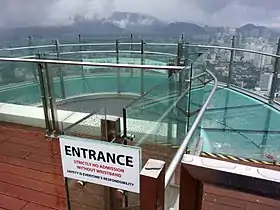
The Top
The renovation works conducted by OWG are intended to turn Komtar Tower into a modern tourist attraction in the heart of George Town. Collectively, the renovation project was officially named 'The Top'.
The attractions are as follows.[37]
- Rainbow Skywalk (Level 68) – Horseshoe-shaped cantilever bridge with a glass walkway.
- The Gravityz (Level 65) – a 90-metre-long (300 ft) rope course along the exterior of the 65th floor, including a zip-line challenge
- Coco Cabana Bar & Bistro (Level 68) – Fine dining section.
- Tower Club Penang (Levels 59, 60, 66 & 67) – Lounge, clubhouse and gym.
- Observatory Deck (Level 65)
- Top View Restaurant and Lounge (formerly known as 59Sixty) (Levels 59 & 60)
- The Grand Ballroom (Level 5).
- Theme parks (Levels 3, 4, 5 & 6).
- Penang State Gallery
- Playote – live feed-enabled customised augmented reality game.
- 5D Sea Explorer
- 7D Planetarium Dome
- Jurassic Research Centre
- The Top Picks
Dewan Tunku Geodesic Dome (Tech Dome Penang)
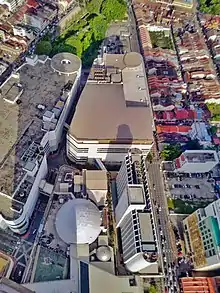
The Dewan Tunku Geodesic Dome, located on level 5, is a partial-spherical structure based on a pattern of circles called geodesics which intersects to form triangular elements. These triangular elements spread the stress across the entire structure. It is based on a concept studied, developed and popularised by R. Buckminster Fuller.
The main entrance to the Geodesic Dome is from the auditorium level and is also accessible from level 4.
The multi-purpose hall Dome was used for performances, official functions, concerts and other events.
As part of the recent renovation works, the Dome and the squash centre have been transformed into Tech Dome Penang. The dome now contains the following galleries:[38]
- Optics – demonstrates the unique characteristics of different types of light.
- Information technology – celebrates the humble sand and its place in modern technology.
- Life tech – takes a walk through the sciences and technologies that maintain human health.
- Robotics – an apartment coming to life with robotics showing contemporary as well as future applications of robotics including for entertainment, medicine, rescue, military, industry, education and household.
- Exploration zone – a space dedicated to young children with games and activities that challenge them to think, explore and play while indirectly learning scientific concepts.
- Penang transformation – tells the story of Penang's evolution from the 1960s to the high-technology industries of today.
ICT Digital Mall
ICT Digital Mall @ Komtar, or simply ICT Mall, is a new retail development managed by Venice Gateway Sdn. Bhd. Opened in November 2010, it occupies the space originally occupied by Yaohan Department Store and later by Aktif Lifestyle Store. The new mall is geared towards offering shoppers an array of electrical and electronic products including computer hardware and software, telecommunication products such as cellular phones, cameras and other photography gear.[39]
A food court is also located at level 1 of ICT Digital Mall @ Komtar. To ensure smooth traffic flow to the ICT Mall, an overhead pedestrian bridge is constructed to link the third floor of the ICT Mall to the second floor of 1st Avenue Mall. There's also an existing overhead bridge to link ICT Mall to the 1st & 2nd floor of Prangin Mall.
Pacific Hypermarket & Departmental Store
Pacific Komtar is the 74th outlet chain of The Store Corporation Berhad in Malaysia. Pacific Komtar is occupying the 1st floor of the podium block.[40][41]
Komtar Walk
Komtar Walk, which covers a 155-metre-long (509 ft) stretch parallel to Prangin Road, is a food and beverage hub developed by Pacific Hypermarket & Department Store Sdn Bhd.
Komtar Walk houses F&B outlets underneath an open-air lightweight roof. The 19 outlets, five of which are single-storey ones, stand in a single structure at the foot of the overhead bridge facing the outdoor car park. Seven more are connected to Komtar Tower next to the George Town White Coffee outlet while the remaining seven outlets, which are all double-storey, are located opposite. These two rows are separated by a 5m walkway, which also allows for outdoor seating.[41]
Komtar Bus Terminal
.jpg.webp)
The Komtar Bus Terminal serves as the hub of public bus services within George Town, which is currently provided by Rapid Penang. A large majority of Rapid Penang bus routes within Penang Island radiate from this terminal, thus making Komtar accessible from all parts of Penang Island.
Adjacent buildings
Hotel Jen
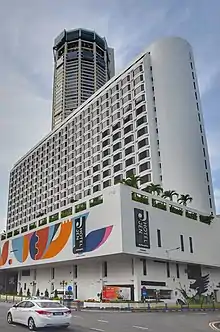
Hotel Jen is a 4-star hotel next to Komtar Tower. It was originally built as part of Phase 2A. Upon completion in the 1980s, it became the Shangri-La Penang and remained so until it was rebranded in the 2000s as Traders Hotel.[42]
Prangin Mall
.jpg.webp)
Prangin Mall was initially planned as part of Phase 3 of the Komtar project. Named after Prangin Road, also known as Jalan Dr Lim Chwee Leong, Prangin Mall was opened in 2001. It caters to a market ranging from lower to middle class. The mall comprises six levels including a basement floor, two levels of basement parking and a further three levels of parking at the upper floors.[43] In recent years, Prangin Mall is also well known for a wide range of electronic retail outlets.[44]
1st Avenue Mall
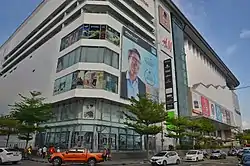
Originally part of Phase 4, 1st Avenue Mall at Magazine Road was completed and opened in 2010. At present, the shopping mall features 655,000 square feet in gross floor area and spreads over 7 retail levels. The mall's top floor also contains a TGV Cineplex.[45]
Future developments
As of January 2017, Phase 5 has never been completed. The area allocated for Phase 5 covers the abandoned historic Sia Boey Market, located just east of 1st Avenue Mall, and is bounded by four streets—McNair Road, Prangin Road (Jalan Dr. Lim Chwee Leong), Magazine Road and Carnavon Street.
Penang Heritage Square
In July 2012, Phase 5 was earmarked by the Penang state government and Penang Development Corporation to be developed into Penang's new heritage enclave, known as Heritage Square. This would be in line with George Town's World Heritage Listing as well as to complement PDC's revitalisation efforts for Komtar as the socio-civic centre and business hub of Penang. This prime 4.5 acres of land in the heart of George Town will predominantly be public space. The Heritage Square and Centre will dedicate, consecrate and restore the cultural vibrancy of George Town by promoting the living heritage and street life in the inner city, as well as greening the city, thus ensuring a balanced development for the area. The project, which is currently under construction, with an objective of revitalising the Komtar Phase 5 area, and to improve the heritage value and significance of the site by creating urban spaces and landscapes for healthy urban living. The development of Heritage Square Project will revitalise the adjacent Komtar building complex which is directed at regaining the glory of Komtar as the nerve centre of Penang.[46]
The components of Penang's Heritage Square consist of the following:
- Restoration and refurbishment of the existing "Sia Boey" (Prangin Market) structure
This will revitalise the "Sia Boey" into a retail and tourist site, comprising among other things a visitors' centre, crafts and souvenir retail areas, flowers and food hubs. To expand the "Sia Boey", market, it is expected that PDC will build an additional adjacent market to complement the existing one for a similar function. This restoration would mark the core zone boundary of the George Town UNESCO Heritage Site.
- Creation of urban spaces
As George Town needs more public space for recreation, public congregation, celebrations and cultural performances, the urban public space which include some green areas will be promoted as the first of its kind in Penang for healthy living. The heritage celebration square will also provide a spot for a centre of culture, arts and traditions in George Town, in turn promoting cultural vibrancy and the concept of melting pot of cultures in the inner city.
- Creation of a Heritage Celebration Square
To refurbish and reinstate the urban setting of the area whereby existing traditional pre-war shophouses along Maxwell Road will undergo adaptive reuse into cafes, coffee shops, tea houses, crafts and handicraft centres, mini-museums, boutiques and B&B hotels which are parallel with the heritage theme. To also reinstate urban setting and usage of the area whereby Maxwell Road will only be limited to pedestrians, and thus promoted as a walking street.
- George Town Heritage Centre (GHC)
This 5-storey building will serve as a venue for arts, cultural, heritage, community, youth and performing activities. The GHC will be raised above street level to provide street plazas for the public.
- Restoration of Prangin Canal
To restore the Prangin Canal with plans for hawkers street food zone and street furniture amidst well-landscaped areas.[47]
In June 2016, however, "Sia Boey" (Phase 5) was identified as a likely site for a transportation hub for the planned Light Rail Transit (LRT) and Mass Rail Transit (MRT) interchange under the Penang Transport Master Plan. The planned Penang Arts District has now been shifted to an alternative 9.2-acre vacant site off Macallum Street Ghaut and Tun Dr Lim Chong Eu Expressway, located 500 metres east of the Sia Boey Market.[48]
References
- "Menara KOMTAR - the Skyscraper Center".
- "Komtar". CTBUH Skyscraper Center.
- "Emporis building ID 122896". Emporis. Archived from the original on 7 March 2016.
- "Komtar". SkyscraperPage.
- Komtar at Structurae
- "Malaysia's highest skywalk opens to public". Channel NewsAsia. Archived from the original on 20 December 2016. Retrieved 9 January 2017.
- hermesauto (7 December 2016). "Rainbow Skywalk, the highest in Malaysia, set to open at Komtar in Penang". The Straits Times. Retrieved 9 January 2017.
- "The World Highest Ropes Course Challenge". www.thesundaily.my. Retrieved 22 July 2018.
- "Kit Siang and family swing along zip-line on Komtar". Free Malaysia Today. 18 February 2018. Retrieved 22 July 2018.
- "World's tallest rope course opening in Komtar this month - Metro News | The Star Online". www.thestar.com.my. Retrieved 22 July 2018.
- Predeep Nambiar (29 July 2019). "Once-filthy Prangin Canal turned into an aquarium". Free Malaysia Today (FMT). Retrieved 8 October 2021.
A secure wall, canal lock and a building made of red brick and mortar showed it was most likely built by the British East India Company in 1804.
- Penang Development Corporation (PDC) & George Town World Heritage Incorporated (GTWHI) (2016). "3.1: Historical Background". Sia Boey Integrated Site Management Plan (PDF). George Town, Penang, Malaysia. p. 3. Retrieved 8 October 2021.
The canal was originally 50 to 80 feet wide, allowing small vessels to transport goods into town, but was gradually narrowed to its current width in the early 1900s.
{{cite book}}: CS1 maint: location missing publisher (link) - Kwee Kim, Chong (11 January 2001). "Paths of Yesteryear" (PDF). George Town, Penang, Malaysia. p. 12. Retrieved 9 October 2021.
Ong (Ong Seng Huat, Malaysia Chinese Historical Relic Survey deputy research director) said Sia Boey market, literally meaning "tail end of the society or community" was called thus because of its location by the Prangin river which was at the edge of town in those days. However, another version has it that the name meant a place where scraps and all things sundry and cheap were sold. After 1890, the southern part of Prangin ditch became more populated with the arrival of many Chinese immigrants from Hui Aun district in China. They stayed at Kuay Khang Ah, meaning 'across the river' (now the area around Jalan C.Y. Choy) and this population is believed to have supported the market activities and retail business at Sia Boey.
- Opalyn Mok (29 July 2019). "Clean Prangin Canal with fishes swimming in it is real, Penang agencies insist". MalayMail. Retrieved 8 October 2021.
The fortification of the Prangin Canal began in 1804 and the canal was narrowed sometime in the 1890s in line with the construction of the Sia Boey Market, which demarcated the influence of the British rule on urban George Town life. They said drawings sourced from the British Library Archive indicated that the original alignment of the canal began at the shorefront of Weld Quay and had extended all the way inland to the Penang Road/Burmah Road junction. At that time, the canal served as a flood mitigation and a waterway, as well as to drain the swamps in surrounding areas for agriculture and residential use. The Prangin Canal was approximately 20 feet wide and five feet deep. The rubble pitched walls of the canal consisted of granite stones and blocks, and the invert was of concrete base overlying the silt strata beneath. The old concrete slabs along the sides of the Prangin Canal were maintained when the old canal was restored under the Sia Boey Rejuvenation Project. The old concrete slabs along the sides of the Prangin Canal were maintained when the old canal was restored under the Sia Boey Rejuvenation Project. The foundation of the canal walls were founded on bakau piles supported by timber shoring, a common construction technique for many pre-war houses in George Town during that era.
- Chong Kah Yuan & Andrea Filmer (2 August 2012). "Remembering Sia Boey". The Star. Retrieved 9 October 2021.
Former Prangin Market Traders Association chairman Tan Ban Bee said the market used to be a gathering place for locals to offer their fruit and vegetables for sale. "Like me, my parents were also traders at the market, which was the most popular one back in the 1940s. At that time, Air Itam, Balik Pulau and Sungai Ara all had vegetable farms and people would transport their goods by bullock cart or by boat up the canal to be brought to the Sia Boey Market to be sold," he said in an interview..."The crowd attracted attention and (from the air) the rickshaws resembled anti-aircraft guns. This may have created the illusion that the locals were preparing for war which resulted in a bomb being dropped on the market in the 1940s. Many people and traders were killed and injured," Tan said.
- "Komtar: Malaysia's Monument to Failed Modernism — Failed Architecture". Retrieved 9 January 2017.
- "Penang Monthly". penangmonthly.com. Archived from the original on 21 October 2016. Retrieved 19 April 2016.
- "Archnet". archnet.org. Archived from the original on 6 June 2012.
- "Penang Heritage Trust". www.pht.org.my.
- Goh, Daniel P.S. (2014). "Between History and Heritage: Post-Colonialism, Globalisation, and the Remaking of Malacca, Penang, and Singapore" (PDF). TRaNS: Trans -Regional and -National Studies of Southeast Asia. 2 (1): 79–101. doi:10.1017/trn.2013.17. S2CID 49577166.
- "Komtar's Hidden Gems". Penang Monthly. 1 May 2016. Archived from the original on 9 January 2017. Retrieved 9 January 2017.
- ""Fire guts upper floors of Penang skyscraper", The Straits Times".
- "Komtar to be transformed into major icon". www.thesundaily.my.
- "Penang's iconic Komtar gets RM50m facelift". 29 October 2013.
- "One level of Komtar car park reserved for fairer sex after upgrading - Metro News - The Star Online". www.thestar.com.my.
- "OWG to finish RM180mil Komtar revitalisation job by year-end - Business News - The Star Online". www.thestar.com.my.
- "Penang Tech Dome: Where science and technology comes alive". 2 August 2016.
- "Tech wonderland set to dazzle kids - Metro News - The Star Online". www.thestar.com.my.
- "An attraction par excellence - Metro News - The Star Online". www.thestar.com.my.
- "Penang's iconic Komtar gets RM50m facelift". 29 October 2013. Retrieved 9 January 2017.
- ""光大长高 68楼注入新生命 KOMTAR Grows Taller, New Lease of Life for 68 Storeys", 光华日报 Kwong Wah Yit Poh". Archived from the original on 12 February 2020. Retrieved 18 April 2016.
- ""一起见证 光大蜕变 Witnessing Together KOMTAR's Metamorphosis", 光华日报 Kwong Wah Yit Poh". Archived from the original on 9 February 2020. Retrieved 18 April 2016.
- "沙魯丁:氣候需求影響 肉雞價微漲合理". 9 January 2016. Archived from the original on 8 December 2017. Retrieved 26 April 2016.
- "Attractions - THE TOP Komtar Penang: Top Penang Attractions & Restaurants". thetop.com.my.
- "Dining - THE TOP Komtar Penang: Top Penang Attractions & Restaurants". thetop.com.my.
- "Contact Us - THE TOP Komtar Penang: Top Penang Attractions & Restaurants". thetop.com.my.
- "Home - THE TOP Komtar Penang: Top Penang Attractions & Restaurants". thetop.com.my.
- "Tech Dome Penang - Penang's 1st Science Discovery Centre". techdomepenang.org.
- "光大數碼城(ICT)展銷會". 23 December 2014.
- "The Store Corporation Berhad - Operator of Supermarkets - Departmental Stores - Hypermarkets". www.tstore.com.my.
- "光大鐘無艳(上):光大復興未盡美". 東方網 - 馬來西亞東方日報. 17 October 2015.
- "4 star Hotel in Georgetown Penang - Hotel Jen By Shangri-La". www.hoteljen.com.
- "Prangin Mall official website". Archived from the original on 20 July 2015.
- "Prangin Mall". Time Out Penang. Retrieved 9 January 2017.
- "1st Avenue Mall".
- "Proposed Heritage Square for Penang". 2 August 2012.
- "Penang's Heritage Square – Reclaiming Public Space For Penangites(en/cn) « Lim Guan Eng". limguaneng.com.
- "Penang arts district relocated to Macallum Street; Sia Boey to be transport hub". 22 June 2016.